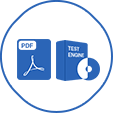Last Update 6 hours ago Total Questions : 105
The Oracle Cloud Infrastructure 2024 Application Integration Professional content is now fully updated, with all current exam questions added 6 hours ago. Deciding to include 1z0-1042-24 practice exam questions in your study plan goes far beyond basic test preparation.
You'll find that our 1z0-1042-24 exam questions frequently feature detailed scenarios and practical problem-solving exercises that directly mirror industry challenges. Engaging with these 1z0-1042-24 sample sets allows you to effectively manage your time and pace yourself, giving you the ability to finish any Oracle Cloud Infrastructure 2024 Application Integration Professional practice test comfortably within the allotted time.
You have a use case that requires a large data extract, which is more than 10MB, to be processed within an Oracle Integration Cloud (OIC) integration. Which are three valid options?
You can recover unsaved changes in an Oracle Integration Cloud (OIC) integration that crashes during design time because of a browser crash, loss of network connectivity, or a server going down. Which statement is NOT true about the unsaved changes feature in OIC?
What is the purpose of adding and configuring a Wait action in a schedule pattern integration flow?
Oracle Integration Cloud (OIC) integrations can be exported so that later they can be imported into another OIC instance environment. Which statement is NOT true about the import and export of OIC integrations?
You have a use case requiring the design of a synchronous Oracle Integration Cloud (OIC) integration flow that returns a custom business fault message to the client if processing fails due to an external runtime fault encountered during the integration instance execution. Which implementation strategy best satisfies this requirement?
Which two statements are TRUE regarding messaging adapters in Oracle Integration (OIC)?
When leveraging the Oracle Integration (OIC) Connectivity Agent for high availability on-premises environments, which two are valid considerations?

